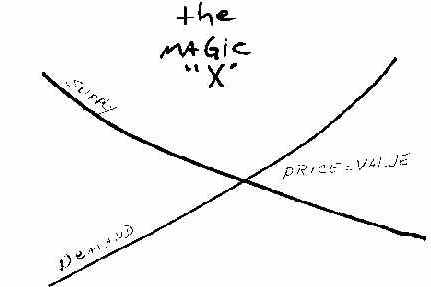Please read the short essay, or just click the answers to these simple questions. You may need to *enable popups.
1. How do capitalists explain "value?"
a. If too many commodities are put on the market, the value will fall
b. If people start paying more for commodities, the supply will rise
d. Falling supply raises value
2. How do capitalists account for the difference in value between a pencil and a skyscraper?
a. There were too many pencils so the value went down
b. There weren't enough skyscrapers so the value went up
d. Producers made more pencils than skyscrapers
*If popups don't work when you click on the answers, you will probably get a yellow line across the top of your screen. Click on it and choose "temporarily enable popups."
 |
What the Capitalists Will Teach You |
On your first day in College Economics Class, your instructor will scribble a big "X" on the chalk board...
He will then explain that one of the lines represents "supply" and the other represents "demand." As one goes down, the other rises. At their intersection, price and value are magically set.
It's the market he's drawn. Nothing has any value, he will say, until this "X" process happens. A paper clip might be worth as much as a steamboat until their value is set by the "X."
If there is time on this first day, he might go on to say that "demand" doesn't really mean what it means in the dictionary -- that somebody wants something. it means that somebody wants something AND can pay for it. "Supply" doesn't mean the amount of goods available, but just the amount of goods that sellers want to offer. They might hold goods off the market to maneuver the price upwards, because they've already seen this "X" and know how it works.
That's more than profound enough for one day, the professor might say.
The magic "X" rule explains everything perfectly, he says. In the rest of your four college years, he will be explaining the exceptions.
Next lesson: Commodities

Please use the form below to provide some feedback, or just send me an e-mail.
